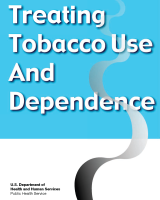NCBI Bookshelf. A service of the National Library of Medicine, National Institutes of Health.
Fiore MC, Bailey WC, Cohen SJ. Smoking Cessation. Rockville (MD): Agency for Health Care Policy and Research (AHCPR); 1996 Apr. (AHCPR Clinical Practice Guidelines, No. 18.)
This publication is provided for historical reference only and the information may be out of date.
General Strategy 1. Common elements of problem-solving/skills-training smoking cessation treatments
Table
General Strategy 1. Common elements of problem-solving/skills-training smoking cessation treatments.
General Strategy 2. Common elements of supportive smoking cessation treatments
Table
General Strategy 2. Common elements of supportive smoking cessation treatments.
General Strategy 3. Suggestions on the clinical use of the nicotine patch
Table
General Strategy 3. Suggestions on the clinical use of the nicotine patch.
General Strategy 4. Clinical guidelines for prescribing nicotine replacement products
Table
General Strategy 4. Clinical guidelines for prescribing nicotine replacement products.
General Strategy 5. Suggestions for the clinical use of nicotine gum
Table
General Strategy 5. Suggestions for the clinical use of nicotine gum.
Table
General Strategy 6. Components of clinical interventions designed to enhance motivation to quit smoking: the "4 Rs".
General Strategy 7. Components of minimal practice relapse prevention interventions
- Every ex-smoker undergoing relapse prevention should receive congratulations, encouragement, and a statement of concern on the part of the clinician that the patient remain abstinent.
- The clinician should encourage the patient's active discussion of the topics listed below. The clinician should ask the patient open-ended questions designed to initiate the patient's problem solving on these topics (e.g., How has stopping smoking helped you?):
- The benefits, including potential health benefits, the patient may derive from cessation.
- Any success the patient has had in quitting (duration of abstinence, reduction in withdrawal, etc.).
- The problems encountered or anticipated in maintaining abstinence (e.g., depression, weight gain).
- Anticipated problems or threats to maintaining abstinence.
General Strategy 8. Components of prescriptive relapse prevention intervention
Table
General Strategy 8. Components of prescriptive relapse prevention intervention.
General Strategy 9. Clinical issues when assisting a pregnant patient in smoking cessation
Table
General Strategy 9. Clinical issues when assisting a pregnant patient in smoking cessation.
Table
General Strategy 10. Clinician statements to help a patient prepare for, and cope with, postcessation weight gain.
General Strategy 11. Suggested interventions for clinicians to prevent the initiation of tobacco use
- Begin in the early elementary school grades to discuss tobacco use and its negative effects -- especially the short-term negative effects.
- Ask the child if s/he has experimented with tobacco.
- Identify the advantages of not smoking, including those most appropriate for the patient's age and developmental stage.
- Discuss the fact that the child eventually will encounter peers who smoke, and discuss ways in which the child might resist peer pressure to try tobacco products.
For youngsters approaching middle school/junior high school age, provide the following information:
- Most kids don't smoke or use smokeless tobacco.
- All forms of tobacco (snuff, cigarettes, dip, etc.) are extremely addictive, and most teens who use tobacco are addicted to nicotine.
- Addiction to tobacco takes away one's independence.
- Smokeless tobacco is not a safe alternative to smoking, because it is addicting and causes oral cancer.
- Smoking makes a person smell bad, stains teeth and skin, causes shortness of breath, decreases athletic performance, ruins clothes, and is a major cause of fires and deaths.
- Smoking causes health problems in many young people, including chronic cough and sore throat.
- Smoking won't make a person rugged, sexy, "cool," or successful.
- Tobacco use is a gateway to other drug use, and addiction to nicotine may make a person more susceptible to trying other dangerous drugs.
- Tobacco is expensive -- spending money on tobacco will mean less money for other things (e.g., books, clothes, make-up, music, movies, sports).
- There are other ways of being different without taking up a habit that is addicting and has such severe, long-term consequences.
- General Strategies - Smoking CessationGeneral Strategies - Smoking Cessation
- PHD finger protein 20-like protein 1 isoform X3 [Rattus norvegicus]PHD finger protein 20-like protein 1 isoform X3 [Rattus norvegicus]gi|1958789576|ref|XP_038935118.1|Protein
- ISPD (36)Books
- SPAR_L00860 [Saccharomyces paradoxus]SPAR_L00860 [Saccharomyces paradoxus]Gene ID:54632176Gene
- PtrM4_061920 [Pyrenophora tritici-repentis]PtrM4_061920 [Pyrenophora tritici-repentis]Gene ID:6340850Gene
Your browsing activity is empty.
Activity recording is turned off.
See more...

